The Best Stretches to Relieve the Aches and Pains of Standing All Day
We know sitting is bad for you but can standing all day cause problems, too? Here’s what you need to know.
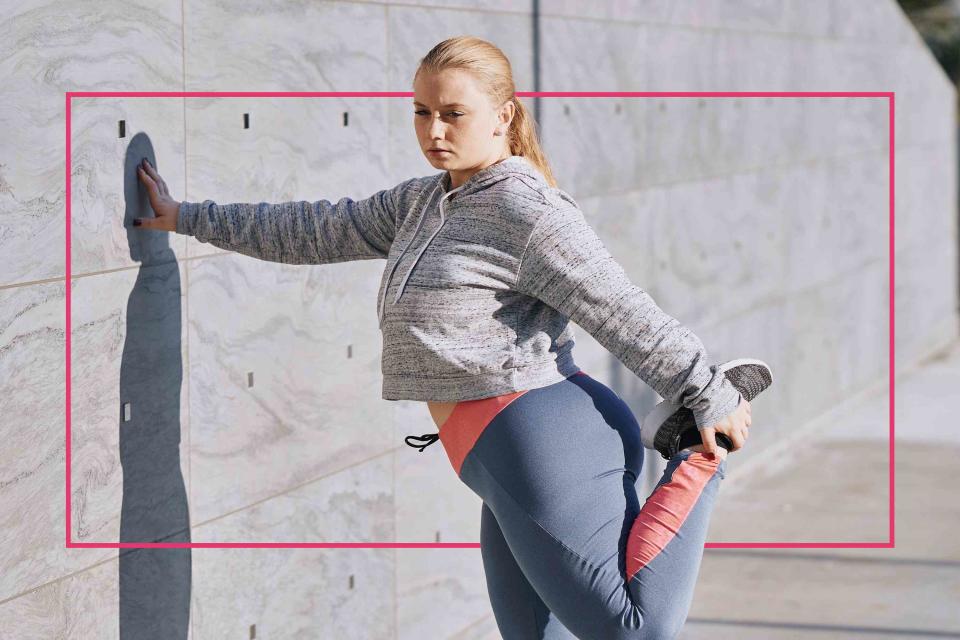
Getty Images
We all know how unhealthy sitting all day can be. Inactivity for extended periods of time can lead to increased risk for obesity, cardiovascular disease, and metabolic syndrome. Therefore, it’s important to stand up and move. But on the other side of the spectrum, can standing all day—by choice or for work—be unhealthy, too? Can you stand too much?
“Standing all day, when you’ve not built-up standing hours over time, is like starting with a marathon as your first run instead of a 5k,” explains Jordan Metzl, MD, sports medicine physician at the Hospital for Special Surgery in New York, NY. “The back, hips, and legs can get very sore from prolonged standing.”
Standing all day can also certainly have benefits, but that’s assuming that you’re standing with great posture, too. “The reality is that most people tend to fall into faulty standing patterns that only make the problems they were trying to avoid worse,” says Sean Light, MA in sports performance, former Los Angeles Lakers strength and conditioning coach, and founder of 4A Health.
Related: The 10 Best Sneakers for Standing All Day of 2023, According to Podiatrists
The Challenges of Standing All Day
Whenever a person remains in the same static postural position for too long, we begin to become concerned about certain tissues being loaded too much and others not being loaded enough, explains Tom Walters, PT, DPT, OCS, owner and founder of Rehab Science.
“With prolonged standing, soreness often occurs in the arches of the feet and low back as the tissues in those regions are directly loaded during standing,” he says. “The muscles and connective tissues in these regions can become fatigued, which can lead to the development of pain.
Postural imbalances are less of a concern when standing as opposed to sitting. “That’s because the joints are held in a neutral position when standing,” explains Dr. Walters. “However, prolonged standing can lead to stiffness and muscle tightness in the low back and lower extremity joints, too.”
Another reason why standing for too long can become a concern is because the anatomy of the body is actually not symmetrical on both sides. “You have a liver on the left and a heart on the right. three lobes of lungs on the left and only two lobes of lungs on the right,” explains Light. “This asymmetry produces an aggressive and natural bias to the right side, which is why most people stand with their weight mostly on their right leg—as seen in the famous Statue of David. To accommodate this, the body produces a predictable sequence of muscle tension and postural imbalances that will only be rectified by giving more love to the left side of your body through exercise and stretching.”
Therefore, if you know you’re going to be standing all day—whether for work, an activity like 18 holes of golf, or maybe you’re touring exhibits on vacation—it’s important to stretch beforehand.
“Stretching the muscles will give you more freedom, flexibility, and surprisingly, more energy throughout your day,” explains Light. “ For example, if you stretch your lats or even the tissue around your ribcage, you'll increase the amount of oxygen your body can take in through inhalation.” And the more oxygen you have, the more energy that is transported into your bloodstream and eventually to the muscles, giving you a more energetic and enjoyable day.
Planning on being on your feet all day? Try these stretches below to help prepare your body beforehand.
Lower Body Stretches
Inchworm
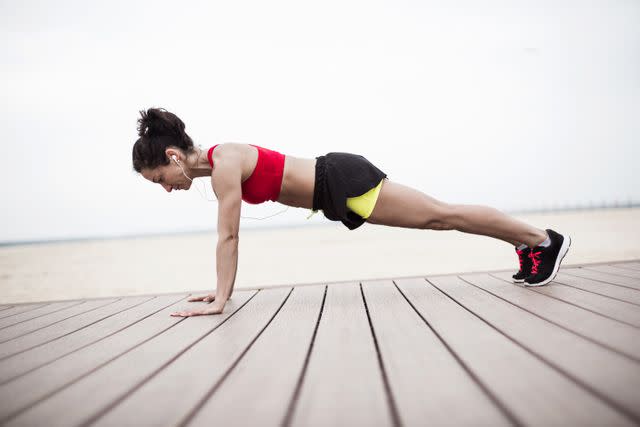
Getty Images / mihailomilovanovic
Stand with feet shoulder-width apart. Reach hands towards the ground and slowly walk them forward until you’re in a plank position. Slowly walk the hands back towards the feet and return to standing.
“While I usually prescribe this for calves, Achilles, and even plantar fasciitis tension, it actually has a huge effect on the entire body,” explains Light. “There is a line of connective tissue that runs from just above your eyebrows, over your head, down your back, legs and stops under your feet. We call this the ‘superficial back line’ and it’s one of the first places to contract when you get stressed. This global stretch has the real power to stop that stress and tension in its tracks.”
World's Greatest Stretch
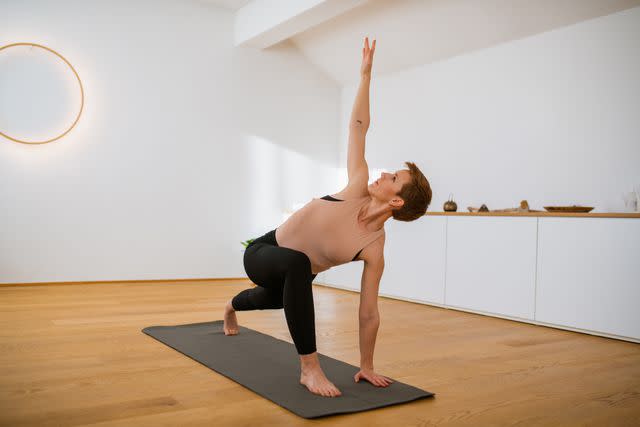
Getty Images / AzmanJaka
Start in the plank position. Step your right foot up and outside of your right hand into a lunge. Lift your right hand off the ground, lower right elbow (or hand) towards the ground, then lift your right arm up towards the ceiling. Hold for 5 seconds. If you were on your elbow, place your right hand back on the ground, and step your right foot back to the plank. Repeat on the other side. Continue alternating 10 times in total.
“This stretch is great for reducing tension in the entire body,” explains Dr. Metzl. “It allows for mobilization in the thoracic spine, hips, and even the ankles, and can increase your range of motion.”
Supine Figure Four Stretch
Lying on your back, extend one leg straight up towards the ceiling. Take the other leg, bend your knee, and place your ankle against the thigh on the straight leg. use your arms to pull the straight leg towards your chest to feel a stretch. Hold for 10 seconds then switch legs and repeat.
“Gluteal region discomfort is commonly seen in people who stand at their jobs and this stretch can help reduce that discomfort,” says Dr. Walters.
“Most people have tight right adductors or groin, and the constant tension in this muscle has been destroying knees, hips, and lower backs since the dawn of time,” explains Light. “Lengthening it with this stretch will give you much-needed relief and the ability to let your pelvis come back to a more restful and neutral position.”
Standing Quad Stretch
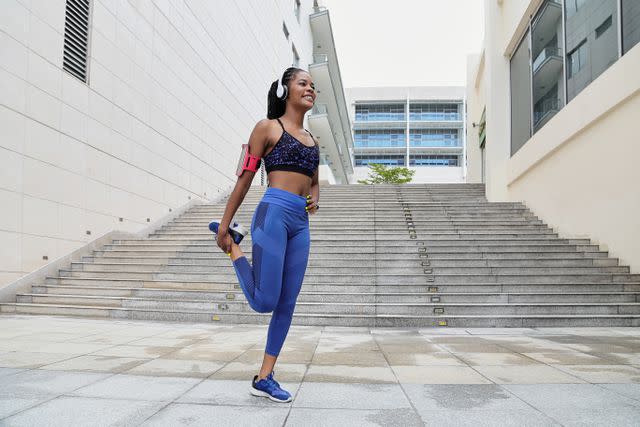
Getty Images / DragonImages
Stand with your feet about shoulder-width apart. Shift weight to one leg, and bend the other knee to kick your foot up towards the glutes. Grab a hold of the lifted foot. Hold for 10 seconds, then switch legs. (Modification: If you have trouble balancing, hold onto a chair, bar, or wall with your free hand).
“Because the knee is held in an extended position when standing, this stretch is a good option because it involves flexing or bending the knee and stretching the quadriceps muscles,” says Dr. Walters. “This unloads the knee temporarily to give it a rest from the loaded extension position associated with standing.”
Upper Body Stretches
Neck Flexion
Sit or stand upright with shoulders back, arms down at sides. Lift and place your hands on the back of your head as you lower your chin towards your chest. Use the weight of your hands to enhance the stretch. Hold for 5 seconds. Repeat 3 times.
“This exercise targets the paracervical muscles,” explains Dr. Metzl, “which are the cause of tightness in the neck. Stretching them helps to release tension and increase mobility.”
Seated Spinal Twist
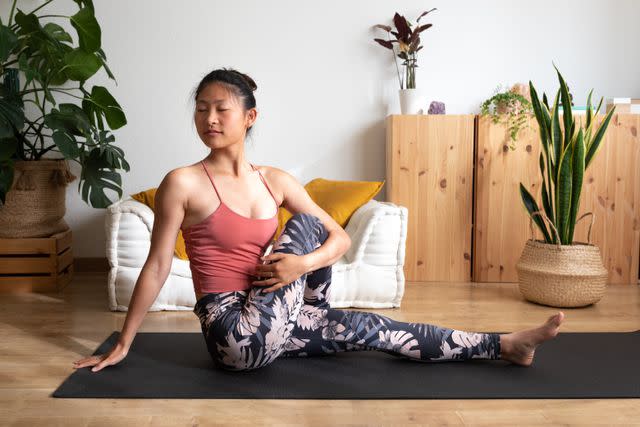
Getty Images / Daniel de la Hoz
Sit upright in a chair (or on the floor with your legs extended straight out in front of you) with your shoulders back, feet flat on the floor. Twist torso to the left, placing right hand outside left thigh, reaching left arm backward. Hold for 10 seconds. Repeat on the other side.
“This allows you to stretch out the paraspinous muscles by rotating the lumbar spine,” says Dr. Metzl. “It can help minimize lower back pain and tension.”
Pec Stretch
Stand in a doorway. Lift one arm and bend the elbow to 90 degrees to allow you to place your forearm on the wall inside the doorway. Step your opposite leg through the doorway. Lean into the front leg until you feel a stretch in the side of your chest with the arm on the wall. Hold for 10 seconds then switch sides.
“Because most jobs involve doing things in front of us, many people will round their shoulders throughout their workday,” says Dr. Walters. “This stretch helps counteract that position.”
Core Stretches
Kneeling Hip Flexor
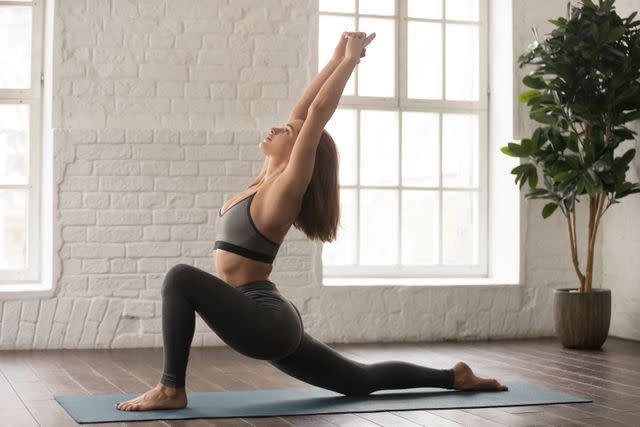
Getty Images / fizkes
Come to a high kneeling position. Step your right foot forward and place it on the ground about two feet forward. Push hips forward, leaning weight into the front foot. Slowly lean the upper body backward with your arms extended for a deeper stretch in the left hip flexor. Hold for 10 seconds. Repeat on the other side.
“This stretch targets the muscles in the front of the hip and hip flexors,” explains Dr. Metzl. These muscles can tighten when you’re in a static position for an extended period of time.
Child's Pose
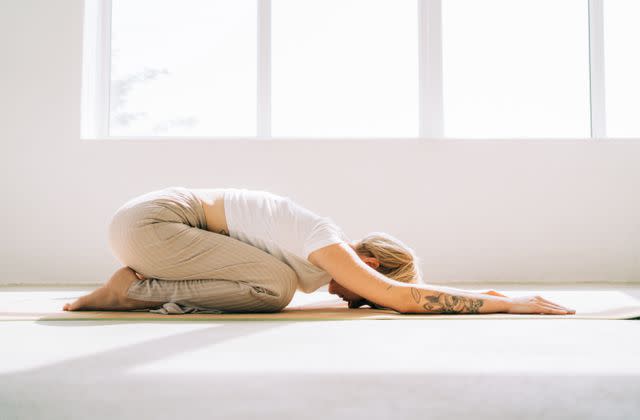
Getty Images / Anna Efetova
Come to the ground and sit on your knees. Separate your knees wide, and reach your arms forward as you lower your upper body towards the ground until your arms and forehead are resting on the ground. Continue to actively reach the arms forward. Hold for 15 seconds.
“Standing all day places the low back or lumbar spine in extension,” says Dr. Walters. “The child’s pose stretch is typically helpful because it stretches the spine into flexion. This helps reduce pain and ensures that the spine gets a break from extension.”
Rib Stretch
Take a normal breath in and then exhale absolutely all of your air. You'll feel your abs get super engaged towards the end of this exhale. Keeping your abs engaged, take another breath in. This inhale will create a ton of pressure inside of your ribs and produce a re-positioning force from within. Repeat for 10 breaths.
“The air you inhale will push out against your ribs and start forcing those intercostal between the ribs to stretch,” says Light. “If you only try one thing, do this exercise, and after five breaths, it can produce stress relief, tension relief, an increase in mobility, and it can help calm the nervous system."
Additional Tips for People Who Stand All Day
Besides the stretches above, there are still a few other things to keep in mind if you’re going to be standing for prolonged periods of time.
Tips for People Who Stand All Day
Take breaks from standing (sit, march in place, walk around)
Wear the correct footwear
Cross-train with walking, strength training, stretching, yoga, etc.
First, remember to take breaks from standing. This could mean sitting, marching in place, or even walking for five to ten minutes every hour. “Changing position and moving will help take stress off sensitive tissues and reduce pain,” says Dr. Walters.
Plus, walking allows you to do your best thinking, Light says. “Have you ever noticed that you think best when walking? This is because your entire body is built around ‘gait mechanics,’ meaning that every action, process, and movement your body makes is designed around walking.” Feeling tension? You're probably not walking enough. Feeling stressed? You're probably not getting in your steps. “Most of the physical problems I see come from not walking enough or walking incorrectly,” says Light. For those on their feet all day, Light recommends taking a prolonged walk (approximately 30 minutes) at least two to three times per week for a good reset.
And make sure you’re wearing the correct shoes! One thing that has become increasingly clear is that footwear acts as a buffer between the ground and the body explains Dr. Metzl. “Having the correct amount of cushion, enough to lessen the ground reactive forces from walking all day, while not being so cushioned that you’re falling into unhealthy foot and ankle positions, is the challenge of getting the right pair of work shoes,” he says.
Another consideration? Keeping the body healthy and fit as a whole. “The better your muscle tone, the less the aches and pains will add up over time,” says Dr. Metzl. “Exercises such as yoga, Pilates, and strength training all build total body strength and flexibility and can be very helpful with building and maintaining fitness and therefore reducing aches and pains.”
For more Shape news, make sure to sign up for our newsletter!
Read the original article on Shape.

